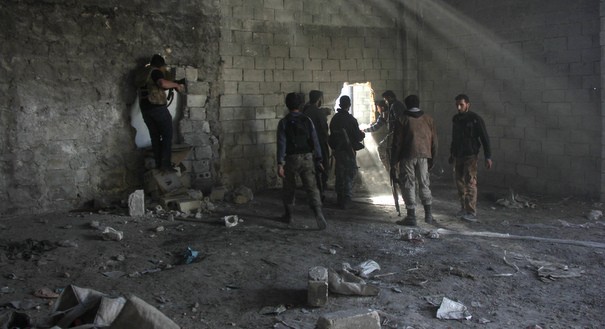In recent months, Syria’s military opposition has witnessed the emergence of many large rebel alliances. Some of the brigades have unified to fight the regime and Islamic extremists by coordinating effectively while others were seeking visibility to showcase their relevance and get foreign funding. Other rebels have united because of all of the above and, in addition, the ambition to spread a certain kind of ideology to the rest of the country.
The Sham Legion, or Faylaq al-Sham in Arabic, belongs to that last category. Announced on March 10, 2014, it aims to “unify the ranks” of Syria’s moderate Islamists. It gathers nineteen midsize brigades scattered from Damascus to Aleppo but mainly effective in the areas of Homs, Hama, and Idlib, where in the past month they have participated in major operations like the Khan Sheikhoun, Hesh, Morek, and Babolin battles.
The emergence of the Sham Legion may be a significant political development because, until its formation, only more conservative and Salafi-oriented brigades had managed to merge into ideologically coherent countrywide alliances, such as the Islamic Front. While that umbrella group has openly called to transform Syria into a Sunni theocracy, leaders of the Sham Legion that we have interviewed insist on “ending injustices by extremist groups,” “promoting democracy,” and “defending religion.”
The CPC Reloaded?
The Sham Legion’s leader is Mondher Saras, a previously little-known member of the rebel Homs Military Council. But he may be a figurehead. Most of the brigades that are now operating under the Sham Legion were previously part of a network of moderate rebel groups sponsored by the Commission for the Protection of Civilians (CPC), which is the real driver behind the new platform.
The CPC has an interesting background. Set up in January 2012 by Haitham Rahmeh, a Sunni cleric who left Syria in the early 1980s before moving to Sweden, it was one of the first organizations to send money and supplies to rebel groups in Homs when the regime’s response to the uprisings turned violent.
Rahmeh and his colleague in the CPC, Nazir Hakim, a France-based activist close to the Syrian Muslim Brotherhood, have since become important members of opposition coalitions such as the Syrian National Council and the National Coalition for Revolutionary and Opposition Forces, currently the dominant umbrella group in exile for Syrian opposition movements. Their successes have allowed the CPC to extend the range of its military activities to other areas of Syria including Hama, Idlib, Aleppo, and to a lesser extent Damascus. But their actions have sometimes lacked coherence, organization, and visibility—the Sham Legion aims at bridging those gaps.
“The Sham Legion was formed to keep up with the movement of military unifications among rebels and to have a place among the large new formations that have appeared recently, such as the Islamic Front and the Syria Revolutionaries’ Front,” a leader of the CPC told us. He was blunt about the continuity between the CPC and the Sham Legion: “We strongly pushed for the emergence of this new body.”
Splits From the Muslim Brotherhood
In addition, three rebel brigades that were previously not part of the CPC came to reinforce the Sham Legion. These are the Fatiheen Brigade, the Eman Brigade, and the Sihem al-Haq Brigade—all midsize groups active in the Idlib and Hama countryside. In order to join the Sham Legion, they split from another moderately Islamist rebel alliance called the Revolution Shields Commission—a loose network of dozens of rebel groups funded and supported by the Syrian Muslim Brotherhood about which we’ve previously written here.
Gaining visibility and, thus, obtaining access to more funding seems to have been the primary driver behind the split of these three brigades. The CPC leader told us that the commission “encouraged these brigades to leave the shields, which is currently in an unusual state of austerity due to a scarcity of resources, and to join the new legion.” This also bolsters the CPC’s long-standing claim that it isn’t part of a “Muslim Brotherhood plot” to take over the Syrian armed opposition. By encouraging splits from the Brotherhood-backed shields, the CPC may have hoped to showcase the Sham Legion’s and its own independence. “Brotherhood leaders criticized our calls for shields brigades to defect and join the new legion, which is not subject to them even in appearance—they were affected negatively by our move,” explained the CPC leader.
Saudi Blessing
Distancing itself from the Muslim Brotherhood is also part of the Sham Legion’s bid to attract Saudi support at a time when Riyadh’s efforts to counter the global Islamist organization have begun to affect the Syrian branch negatively.
The leaders of the CPC have done their utmost in the past year to strike a distinctively pro-Saudi tone, for instance by having the commission’s two representatives in the Syrian opposition vote in favor of “the kingdom’s candidate,” Ahmad al-Jarba, during the National Coalition leadership elections in July 2013 and again in January 2014. The CPC’s main financier, a Syrian businessman from Homs, lives in Saudi Arabia and has close ties to policymakers in the kingdom.
“Our most significant challenge was to overcome the perception that we are affiliated with the Brotherhood,” confirmed a CPC leader. “For long, this idea was prevalent but we are now increasingly seen as Islamists who are not part of the Brotherhood—and this has encouraged Saudi Arabia to support the Sham Legion and to improve our military capabilities.”
But whether the Sham Legion can successfully compete for influence with stronger Salafi rebel alliances without the Brotherhood’s blessing remains to be seen.
Ali El Yassir is a Beirut-based analyst focusing on political and security issues in Syria and Lebanon.






